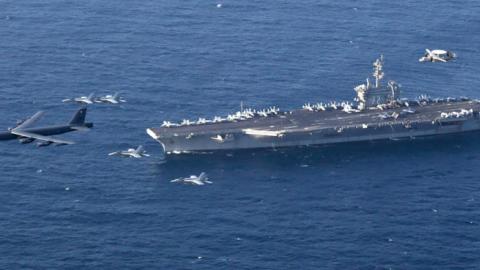America as a Seapower
The United States is a “seapower” in all senses of the word. Its history, prosperity, and security are inseparable from the oceans. Even U.S. states without coastlines depend on global supply chains and markets that move primarily through the oceans.
The United States neglects its Navy at its peril. But military power must be accompanied by other types of power, both hard and soft. In his analysis of five maritime great powers, Professor Andrew Lambert explains how might and identity derive not exclusively from naval power, but also from the aptitude for using the seas cooperatively. The crucial distinction between seapowers and more insular continental powers is the art of perpetuating profitable economic and political ties with others. “A seapower, the ancient Greek thalassokratia,” writes Lambert, “was a state that consciously chose to create and sustain a fundamental engagement between nation and ocean, from political inclusion to the rule of law, across the entire spectrum of national life, in order to achieve great power status.”
The oceans are not just the cradle of life, but vital arteries to tomorrow’s world centers of power. The continuous body of water that facilitates 90 percent of global trade and comprises about 72 percent of the Earth’s surface joins the United States with two major oceans and connects it to the dynamic Indo-Pacific region where the majority of twenty-first century wealth, trade, and population are concentrated.
Because America’s peace and well-being depend on unhampered access and use of the oceans, order at sea is indispensable for U.S. global strategy and its vision of preserving and adapting a “free and open Indo-Pacific,” the Trump administration’s vision for an expanded regional policy announced during the president’s first trip to Asia.
The post-World War II international system enshrined the idea of “freedom of the high seas” in the 1945 United Nations Charter. Postwar challenges to commercial and military freedom of navigation, however, demanded further protection.
In the midst of the Cold War, both Western and Eastern blocs along with nonaligned nations came together to support the multilateral negotiations that resulted in the 1982 UN Convention on the Law of the Sea (UNCLOS). The Third United Nations Conference on the Law of the Sea does not conform with the revisionist notion that the United States imposed its rules on others. Instead, as Singapore Ambassador Tommy Koh, who later served as president of the conference, put it, “You will find countries allied here that you will not find working together in any other international forum, such as Mongolia and Swaziland, or Jamaica and Iraq.” As U.S. Ambassador John Norton Moore said, freedom of navigation is the original “common heritage” of all humankind.
From the signing of UNCLOS, the United States accepted all of its provisions as customary international law. The sole exception was Part XI regarding seabed exploration and mining in international waters, outside countries’ territorial waters and Exclusive Economic Zones (EEZs). In short, the United States helped to establish international law of the sea, and despite not ratifying UNCLOS, seeks to ensure its relevance, survival, and enforcement.
So, freedom of seas has been and remains essential for all Americans. However, maritime order is increasingly at risk and from both traditional and nontraditional threats. A critical question is whether we can sustain freedom of the seas into the future.
Rising Challenges for Maritime Order
Maritime order is a larger concept than maritime security. The maritime domain is defined as “all areas and things of, on, under, relating to, adjacent to, or bordering on a sea, ocean, or other navigable waterway including all maritime-related activities, infrastructure, people, cargo, and vessels and other conveyances.” Although security is the sine qua non for order, there is a symbiotic relationship between freedom of navigation on the oceans, for instance, and sustainable coastal communities where almost two-thirds of the world’s mega-cities are situated.















